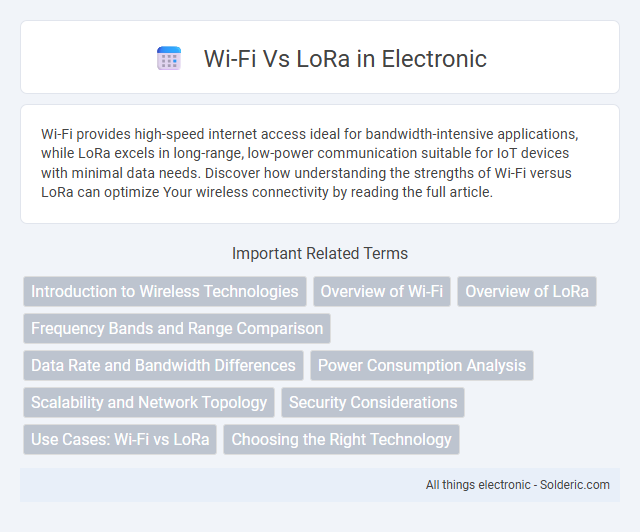Wi-Fi provides high-speed internet access ideal for bandwidth-intensive applications, while LoRa excels in long-range, low-power communication suitable for IoT devices with minimal data needs. Discover how understanding the strengths of Wi-Fi versus LoRa can optimize Your wireless connectivity by reading the full article.
Comparison Table
| Feature | Wi-Fi | LoRa |
|---|---|---|
| Frequency Band | 2.4 GHz / 5 GHz | Sub-GHz (e.g., 868 MHz, 915 MHz) |
| Range | Up to 100 meters | Up to 10 kilometers |
| Data Rate | Up to 1 Gbps (Wi-Fi 6) | 0.3 kbps to 50 kbps |
| Power Consumption | High | Very Low |
| Use Case | High-speed internet, video streaming, file transfer | IoT sensor data, long-range communication, smart cities |
| Network Topology | Star, Mesh | Star |
| Security | WPA2/WPA3 encryption | AES 128-bit encryption |
| Deployment Cost | Moderate to High | Low |
Introduction to Wireless Technologies
Wi-Fi and LoRa represent distinct wireless technologies tailored for different applications; Wi-Fi offers high-speed connectivity ideal for local area networks, while LoRa provides long-range, low-power communication suited for Internet of Things (IoT) devices. Wi-Fi operates primarily in the 2.4 GHz and 5 GHz bands, delivering data rates up to several gigabits per second, whereas LoRa utilizes unlicensed sub-GHz frequency bands to achieve extended coverage with minimal energy consumption. Understanding the trade-offs between Wi-Fi's high throughput and LoRa's extensive wireless range enables you to select the best protocol for your connectivity requirements.
Overview of Wi-Fi
Wi-Fi is a wireless networking technology based on IEEE 802.11 standards that enables high-speed internet access within short to medium ranges, typically up to 100 meters indoors. It operates primarily in the 2.4 GHz and 5 GHz frequency bands, supporting data rates from several Mbps to multiple Gbps in the latest Wi-Fi 6 and Wi-Fi 6E standards. Wi-Fi is widely used in homes, offices, and public hotspots for bandwidth-intensive applications like video streaming, online gaming, and large file transfers.
Overview of LoRa
LoRa (Long Range) technology is a low-power, wide-area network (LPWAN) protocol designed for long-distance communication with minimal energy consumption, ideal for IoT applications. It operates in unlicensed sub-gigahertz frequency bands, providing robust signal penetration and extended coverage up to 15 kilometers in rural areas. LoRa networks support devices with low data rates, making them suitable for sensor data transmission and smart city deployments where battery life and range are critical factors.
Frequency Bands and Range Comparison
Wi-Fi operates primarily in the 2.4 GHz and 5 GHz frequency bands, offering high data rates but limited range typically up to 100 meters indoors. LoRa uses sub-GHz frequency bands such as 868 MHz in Europe and 915 MHz in North America, enabling long-range communication up to 15 kilometers in rural areas with low power consumption. Your choice depends on whether you prioritize high-speed connectivity in confined spaces or extended coverage for IoT applications over vast distances.
Data Rate and Bandwidth Differences
Wi-Fi offers significantly higher data rates, typically ranging from 54 Mbps to several Gbps, using bandwidths between 20 MHz and 160 MHz, enabling fast data transfer ideal for high-demand applications. LoRa operates at much lower data rates, generally between 0.3 kbps and 50 kbps, with narrow bandwidths around 125 kHz to 500 kHz, optimizing long-range, low-power communication for IoT devices. Your choice between Wi-Fi and LoRa should consider whether high throughput or extended range with low power consumption is the priority.
Power Consumption Analysis
Wi-Fi consumes significantly higher power compared to LoRa, making LoRa ideal for battery-powered, long-range IoT devices requiring extended operation. LoRa's low data rate and efficient modulation scheme optimize energy use, enabling multi-year battery life in sensors and remote monitoring applications. Wi-Fi's higher throughput comes at the cost of frequent transmissions and complex protocols that increase power draw, limiting its suitability for low-power, wide-area deployments.
Scalability and Network Topology
Wi-Fi networks typically support limited scalability, suited for dense environments with fewer nodes due to higher power consumption and shorter range, using star or mesh topologies. LoRa excels in scalability by enabling thousands of low-power nodes over long distances with a star-of-stars topology, making it ideal for extensive IoT applications. LoRa gateways manage vast devices efficiently, whereas Wi-Fi infrastructure faces challenges in accommodating large-scale deployments without significant performance degradation.
Security Considerations
Wi-Fi networks typically use WPA3 encryption protocols, offering robust security features such as individualized data encryption and enhanced authentication mechanisms, which protect against unauthorized access and eavesdropping. LoRa technology, designed for low-power wide-area networks (LPWAN), employs AES-128 encryption to secure data transmission, focusing on lightweight security suitable for IoT devices with limited computational resources. While Wi-Fi provides higher data rates and stronger security for dense network environments, LoRa's encryption strategy prioritizes energy efficiency and long-range communication security, making it ideal for distributed sensor networks.
Use Cases: Wi-Fi vs LoRa
Wi-Fi is ideal for high-bandwidth applications like video streaming, online gaming, and office network connectivity within homes or businesses due to its fast data rates and low latency. LoRa excels in long-range, low-power IoT applications such as smart agriculture, remote environmental monitoring, and asset tracking where devices require extended battery life and operate over several kilometers. While Wi-Fi supports dense urban environments with high device density, LoRa is optimized for wide-area networks with sparse devices transmitting small amounts of data intermittently.
Choosing the Right Technology
Choosing the right technology between Wi-Fi and LoRa depends on your specific connectivity needs and environment. Wi-Fi offers high data rates and is ideal for short-range applications within homes or offices, supporting devices requiring continuous internet access. LoRa excels in long-range, low-power communications, making it suitable for IoT deployments like smart agriculture or remote sensor networks where battery life and coverage are critical.
Wi-Fi vs LoRa Infographic

 solderic.com
solderic.com